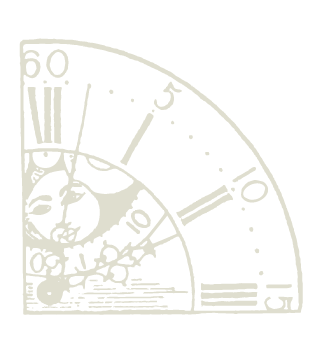Signature COLLECTION
TIME IN HAND

Time in Hand have procured a number of particularly significant timepieces and
continue to do so as opportunities arise. Take a look at some of our featured clocks below...
3484 Carriage Clock £850.00
Jean-André Lepaute
23 November 1720 – 11 April 1789

Jean-André Lepaute, together with his younger brother Jean-Baptiste Lepaute was a founder of an outstanding French clockmaker dynasty of their day, holding the brevet horlogers du Roi. His brother assumed his workshop in 1774, when Jean-André retired; he died after a long illness at Paris.
Born at Thonne-la-Long in Lorraine, Lepaute arrived in Paris as a young man. His brother joined him in 1747. Before he was received maître by the clockmakers' guild in 1759, he had made such a reputation with several public clocks, notably at the palais du Luxembourg, the château de Bellevue and the château des Ternes that he was given lodgings in the Luxembourg. His clock at the École Militaire, Paris, still runs.
Lepaute was an innovator, to whom numerous improvements are due, especially his pin-wheel escapement. He constructed refinements to the clockwork in which the gears are all in the horizontal plane, making possible the revolving dials of clocks in urns (illustration, right) or in globes characteristic of the classicizing Louis XVI style. Three editions of his Traité d'Horlogerie were published in Paris, in 1755, 1760 and 1767. A small volume, Description de plusieurs ouvrages d'horlogerie ("A Description of several works of clockmaking") appeared in 1764. His wife, whom he married in 1748, was the astronomer Nicole-Reine Lepaute, who nursed him in his long last illness. His nephew was the clockmaker, mathematician and astronomer Joseph Lepaute Dagelet who accompanied Lapérouse on his fateful scientific navigation. A nephew, Pierre-Basile Lepaute (1750–1843) carried the firm well into the 19th century.
This particular clock came from York Town Hall. It was connected to an electric circuit which had an impulse running through it, connecting it to all the other 'slave' clocks in the building. It would have been regarded as the 'master' clock. The Gridiron pendulum, invented by John Harrison has full temperature compensation.The rods are made of steel and brass, to counteract each other. This clock is regarded as a highly reliable clock. Another of its kind can be found in the Royal Collection. Today, we use our clock to regulate all of the other clocks in the shop.

Clock cleaned and polished

Clock cleaned and polished

Franz Trlibler

Little is known about the maker of this truly spectacular and unique Baroque style wall clock. Dating back to around 1690-1700, it is known as a 'Telleruhr' or 'coin' clock. Thought to have originated from Innsbruck, Austria, the intricate floral face is made from solid silver via an elaborate process, whereby the silver would have been placed on a tray, then a bitumen-type substance would have been glued to it. The flower pattern would have been chiselled from the back by hand, then the material melted down to leave an impression of the artwork at the front.
Also featured on the face is the bust of a woman. This indicates that the clock may have been dedicated or gifted to someone in particular although this is purely speculative. In the middle is a fire gilded brass chapter ring with Roman numerals. The hands of the clock are similarly detailed, featuring a dragon breathing fire. The clock is in its original condition, having never been sprayed, painted or treated in any way.
The movement of the clock has the inscription 'I.O Franz Trlibler' on it, the I.O. signifying a man who has been touched or chosen by God. It is derived from the Greek word Ioannes. It is an 8 day Verge movement which is highly unusual for this type of clock. The moving pendulum also features a small red jewel at the end of it. The clock measures 53cm in height and 33cm at its widest point.



Describe your image

Got a similar clock that needs a service? Upload a photo here:

Joseph Mayer

This 19th Century Art Nouveau style German novelty clock is made from spelter and features a bronze-effect patina. Running on a 30 hour movement, the tongue and tail of the dog are fun, animated aspects of this quirky timepiece.
Joseph Mayer (1754-1828) from Waldau near Neustadt sold clocks in the city of Copenhagen and also carried out repair work. He is a close relative of the very famous clockmakers Mathäus Hummel, the so-called “Jägerstieger”, Joseph Ganter, and Benedikt Faller.
His grandson German Mayer (1815-1896), a clockmaker by profession like his four brothers, established the German Mayer Companie in Reading/England in 1838, making himself the head of this association of clock dealers.
In 1841, German’s father Andreas Mayer (1787-1864) sent a delivery of clocks and clock parts to Reading. The invoice, amounting to 937 gulden and 5 kreuzer, was the first written document of Mayer’s clockmaking tradition which is why the year 1841 is considered the year of foundation. In 1900, six to eight clockmakers and assistants were working in Mayer’s clockmaking workshop managed by German’s second oldest son Joseph Mayer (1853-1903). He started to design new types of clocks and also manufactured music boxes.
Alois Mayer (1885-1962), Joseph’s oldest son, established a high-pressure water supply to drive the lathes and other equipment – a significant step towards series production in 1906. Until World War I, the company almost exclusively manufactured so-called “twin alarms” for the English market.
The company was entered in the commercial register under the name of “Alois Mayer, Uhrenfabrik Schönenback” in 1922 . In 1954, it put on the “music clock with four dancing figures”, designed by Heinrich Mayer on the market as the first clockmaking company in the Black Forest.








